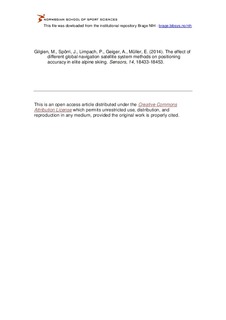| dc.contributor.author | Gilgien, Matthias | |
| dc.contributor.author | Spörri, Jörgen | |
| dc.contributor.author | Limpach, Philippe | |
| dc.contributor.author | Geiger, Alain | |
| dc.contributor.author | Müller, Erich | |
| dc.date.accessioned | 2015-03-20T11:05:39Z | |
| dc.date.available | 2015-03-20T11:05:39Z | |
| dc.date.issued | 2014-10-03 | |
| dc.identifier.citation | Sensors. 2014, 14, 18433-18453 | nb_NO |
| dc.identifier.uri | http://hdl.handle.net/11250/279976 | |
| dc.description | This is an open access article distributed under the Creative Commons Attribution License which permits unrestricted use, distribution, and reproduction in any medium, provided the original work is properly cited. | nb_NO |
| dc.description.abstract | In sport science, Global Navigation Satellite Systems (GNSS) are frequently applied to capture athletes’ position, velocity and acceleration. Application of GNSS includes a large range of different GNSS technologies and methods. To date no study has comprehensively compared the different GNSS methods applied. Therefore, the aim of the current study was to investigate the effect of differential and non-differential solutions, different satellite systems and different GNSS signal frequencies on position accuracy. Twelve alpine ski racers were equipped with high-end GNSS devices while performing runs on a giant slalom course. The skiers’ GNSS antenna positions were calculated in three satellite signal obstruction conditions using five different GNSS methods. The GNSS antenna positions were compared to a video-based photogrammetric reference system over one turn and against the most valid GNSS method over the entire run. Furthermore, the time for acquisitioning differential GNSS solutions was assessed for four differential methods. The only GNSS method that consistently yielded sub-decimetre position accuracy in typical alpine skiing conditions was a differential method using American (GPS) and Russian (GLONASS) satellite systems and the satellite signal frequencies L1 and L2. Under conditions of minimal satellite signal obstruction, valid results were also achieved when either the satellite system GLONASS or the frequency L2 was dropped from the best configuration. All other methods failed to fulfill the accuracy requirements needed to detect relevant differences in the kinematics of alpine skiers, even in conditions favorable for GNSS measurements. The methods with good positioning accuracy had also the shortest times to compute differential solutions. This paper highlights the importance to choose appropriate methods to meet the accuracy requirements for sport applications. | nb_NO |
| dc.language.iso | eng | nb_NO |
| dc.publisher | MDPI | nb_NO |
| dc.subject | positioning | nb_NO |
| dc.subject | kinematics | nb_NO |
| dc.subject | locomotion | nb_NO |
| dc.subject | GPS/GNSS | nb_NO |
| dc.subject | wearable system | nb_NO |
| dc.subject | navigation | nb_NO |
| dc.subject | photogrammetry | nb_NO |
| dc.subject | validation | nb_NO |
| dc.subject | accuracy | nb_NO |
| dc.subject | sport | nb_NO |
| dc.subject | snowsport | nb_NO |
| dc.subject | sports medicine | nb_NO |
| dc.title | The effect of different global navigation satellite system methods on positioning accuracy in elite alpine skiing | nb_NO |
| dc.type | Journal article | nb_NO |
| dc.type | Peer reviewed | nb_NO |
| dc.subject.nsi | VDP::Mathematics and natural science: 400::Physics: 430 | nb_NO |
| dc.source.journal | Sensors | nb_NO |
| dc.description.localcode | Seksjon for fysisk prestasjonsevne / Department of Physical Performance | nb_NO |
